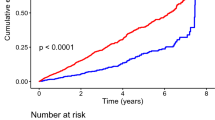Summary
Previous reports have indicated an excess of mortality from coronary heart disease (CHD), cardiovascular disease (CVD), and all causes in subjects with large-vessel peripheral arterial disease (LV-PAD). However, there is little information available concerning the risk of nonfatal events (morbidity) in this patient group.
In a population-based study of 67 patients with LV-PAD and 408 control subjects without this condition, nonfatal CHD and stroke, and total CVD events, morbidity and mortality were evaluated in both men and women. Those with LV-PAD had a 3-fold excess of CVD morbidity at baseline compared with control subjects of the same sex. However, the absolute CVD rates were greater in men than women. During the 10 years of follow-up, women with LV-PAD had more nonfatal CVD events than men, resulting in comparable overall morbidity rates. In logistic regression models adjusted for other CVD risk factors, total CVD morbidity and mortality combined was 2.5 times as great in men and 5 times as great in women with LV-PAD as in those without peripheral arterial disease.
These results suggest that the total morbidity and mortality burden are dramatically increased in both men and women with LV-PAD.
Similar content being viewed by others
References
Blankenhorn DH, Azen SP, Crawford DW, Nessim SA, Sanmarco ME, et al. Effects of colestipol-niacin therapy on human femoral atherosclerosis. Circulation 83: 438–447, 1991
Blankenhorn DH, Nessim SA, Johnson RL, Sanmarco ME, Azen SP, et al. Beneficial effects of combined colestipol-niacin therapy on coronary atherosclerosis and coronary venous bypass grafts. Journal of the American Medical Association 257: 3233–3240, 1987
Breslow NE, Day NE. Statistical methods in cancer research. Vol. I: the analysis of case-control studies. IARC Scientific Publications No. 32, Lyon, France, 1980
Brown G, Albers JJ, Fisher LD, Schaffer SM, Lin J-T, et al. Regression of coronary artery disease as a result of intensive lipid lowering therapy in men with high levels of apolipoprotein B. New England Journal of Medicine 323: 1289–1298, 1990
Canner PL, Berge GK, Wenger NK, Stamler J, Friedman L, et al. Fifteen year mortality in Coronary Drug Project patients: long term benefit with niacin. Journal of the American College of Cardiology 18: 1245–1255, 1986
Criqui MH, Browner D, Fronek A, Klauber MR, Barrett-Conner E, et al. Peripheral arterial disease in large vessels is epidemiologically distinct from small vessel disease: an analysis of risk factors. American Journal of Epidemiology 129; 1110–1119, 1989
Criqui MH, Coughlin SS, Fronek A, Klauber MR, Barrett-Conner E, et al. Non-invasively diagnosed peripheral arterial disease as a predictor of mortality. Results from a prospective population-based study. Circulation 72: 768–773, 1985
Criqui MH, Langer RD, Fronek A, Feigelson HS, Klauber MR, et al. Peripheral arterial disease and subsequent all-cause, cardiovascular, and coronary heart disease mortality: a 10-year prospective study. In press, 1991
Dormandy J, Mahir M, Ascady G, Balsano F, De Leeuw P, et al. Fate of the patient with chronic leg ischaemia. A review article. Journal of Cardiovascular Surgery 30: 50–57, 1989
Feigelson HS, Criqui MH, Fronek A, Langer RD, Molgaard C. Diagnosing peripheral arterial disease: the sensitivity, specificity, and predictive value of non-invasive tests in a population based study. Abstract. Circulation 84(Suppl. II): 336, 1991
Fronek A, Coel M, Bernstein EF. Quantitative ultrasonographic studies of lower extremity flow velocities in health and disease. Circulation 53: 957–960, 1976
Fronek A, Johansen KH, Dilley RB, Bernstein EF. Noninvasive physiologic tests in the diagnosis and characterization of peripheral arterial occlusive disease. American Journal of Surgery 126: 205–214, 1973
ICD.9.CM, International Classification of Disease, 9th Revision, 3rd ed., Practice Management Information Corporation (PMI), Los Angeles, California, 1989
Jonason T, Bergstrom R. Cessation of smoking in patients with intermittent claudication: effect on the risk of peripheral vascular complications, myocardial infarction and mortality. Acta Medica Scandinavica 221: 253–260, 1957
Lipid Research Clinics Program Epidemiology Committee. Plasma lipid distribution in selected North American populations: the Lipid Research Clinic program prevalence study. Circulation 60: 427–439, 1979
National Heart and Lung Institute, National Institutes of Health. Manual of laboratory operations. Lipid Research Clinics Program. Vol 1: Lipid and lipoproteins analysis. DHEW Publication No (NIH) 75-628, Washington, DC, 1975
Strandness Jr DE. Peripheral arterial disease: a physiologic approach. Little, Brown and Co., Boston, 1979
Winsor T. Influence of arterial disease on the systolic blood pressure gradients of the extremity. American Journal of Medical Science 220: 117–126, 1950
Author information
Authors and Affiliations
Rights and permissions
About this article
Cite this article
Criqui, M.H., Langer, R.D., Fronek, A. et al. Coronary Disease and Stroke in Patients with Large-Vessel Peripheral Arterial Disease. Drugs 42 (Suppl 5), 16–21 (1991). https://doi.org/10.2165/00003495-199100425-00005
Published:
Issue Date:
DOI: https://doi.org/10.2165/00003495-199100425-00005




